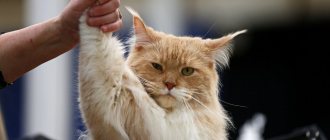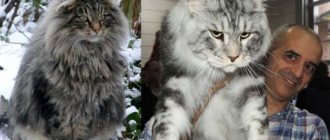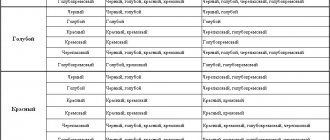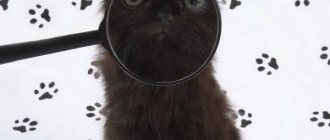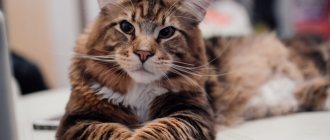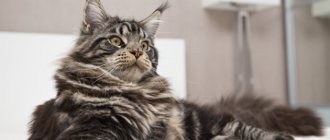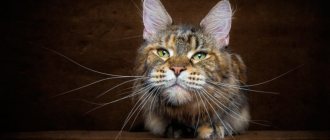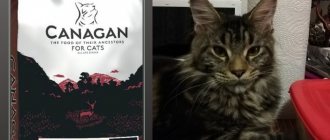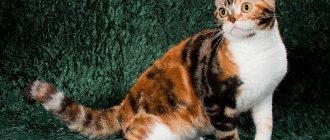The appearance of these domestic animals is closely related to the natural conditions of cold North America. In the article we will get acquainted with the colors of Maine Coons and take a detailed look at colors such as smoke, solid, tortoiseshell, white, red, marble and many others. No person who cares about animals can resist the beauty of these pets.
In our article about the description of the Maine Coon breed, we have already touched on the colors of these cats, today we will look at them in more detail.
Raccoon cat color classes
The color of Maine Coons is distinguished depending on:
- coat color;
- the presence of patterns or their absence;
- the presence of various spots or their absence.
In order to make it easier to distinguish the appearance of a cat of different breeds, taking into account the color of its coat, as well as a number of other characteristics, about 20 years ago the fife Assembly created the first EMS code system. This system was gradually improved, and now it is considered traditional for judging cats in all felinological systems.
Maine Coons are designated by the first letters of the Latin name of the breed – MC (Maine Coon). Since their hair is considered semi-long, coons were included in the II category of purebred cats, and designated with the letters SLH - from the Latin language Semi Long Hair.
Regarding the fur of all mustachioed pets, felinological systems agreed that male cats can only be of two colors - red and black. Other colors are the result of lightening or oxidation of these primary colors. White wool is considered to be a lack of color. Felinologists have noticed that Maine Coon kittens born with a white coat have one or more dark spots on their heads, which subsequently disappear.
The designations used in EMS coding are the first letters of colors or even color genetics in various languages, mainly English and French. White shades and spots on Maine Coon fur, as well as various patterns, are usually designated with a special number.
Maine Coon color chart with codes
| Color code | Color |
| a | blue |
| b | brown, chestnut, chocolate, Havana |
| c | lilac, platinum, lavender |
| d | red |
| e | cream |
| f | tortoiseshell |
| g | creamy blue, tortoiseshell blue |
| h | brown tortoiseshell |
| j | lilac tortoiseshell |
| n | black, wild, sable |
| s | silver, smoke |
| w | white |
| 01 | van (white except for one or more spots on the head, tail or shoulder area) |
| 02 | harlequin (van with spots on the back) |
| 03 | bicolor, two colors |
| 04 | white markings |
| 09 | white spots 1-2 cm in size |
| 11 | shaded hair colors (1/4 part) |
| 12 | veiled hair colors (1/8 part) |
| 21 | stripes, agouti |
| 22 | marble color |
| 23 | brindle color |
| 24 | spotted color |
| 25 | ticked tabby |
So, for example, a Maine Coon with black smoke coloring will be designated as ns. Next, the number of the drawing will be added, if there is one.
Most often in Maine Coons you can find such combinations as n 22, ds 22, d 22, n 23.
Maine Coon d 22
Maine Coon n 22
Maine Coon ns 22
Maine Coon ds 22
Rare and expensive Mei Coon colors
If we consider rare and expensive colors in a broader sense, then we can say with certainty that such colors do not exist. The most expensive and rare color can be considered any color of an animal, which is included in the standards of both American and European systems. But a rather rare occurrence could be, for example, the birth of a kitten that is completely the same color, despite the fact that its parents have fur with some kind of pattern.
Animal health
Pedigree Maine Coon cats, the price of which is discussed with breeders individually, rarely have genetically inherited ailments. Such cats live 15-20 years, and with proper care will have an excellent quality of life.
However, if breeders do not comply with selection rules, cats may have a number of characteristic diseases, such as:
- lameness (due to problems with the hip joints);
- heart diseases;
- polycystic kidney disease;
- problems with the skeletal muscles of the trunk and limbs.
A Maine Coon cat purchased from a professional nursery, the price of which can be quite high, must have all the documents and health certificates confirming that the animal does not have a number of genetic abnormalities.
Tabby
Various stripes on the coat of cats are combined into one name - tabby. In addition, tabbies are identified by expressive rims on the animals’ faces, which very often form the letter “M”. This color is called wild because it resembles real wild cats that live in forest areas.
Maine Coons can have different coat colors and one of three basic tabby patterns:
- Classic (Mackerel tabby);
- Spotted tabby;
- Brindle (Mackerel tabby).
The ticked tabby pattern is also quite common, but unfortunately, it is not recognized for Maine Coon cats. All other tabby patterns can be of any color recognized by the systems.
Classic (marble)
The classic tabby pattern, or marbled as it is also called, consists of wide curls and various continuous lines on the animal’s body.
Maine Coon black marble on silver
Maine Coon black marble with white
Spotted
Spotted Tabby has intermittent stripes on the animal's fur that give the appearance of patterns of spots. The spot can be of any size and any degree of clarity.
Brindle (striped)
The brindle tabby is quite easily recognized due to the vertical stripes that run parallel. Maine Coons, which have brindle coat patterns, often resemble small tigers, which is not at all surprising, because domestic animals are genetically close to large predators.
Maine Coon brindle (Mackerel tabby)
Maine Coon classic (Mackerel tabby)
Maine Coon Spotted tabby
ticked
In this case, there are no spots or stripes. Ticked coloring can be recognized by the characteristic pattern on the cat's face and agouti throughout the body.
If you look closely at each hair of a cat with a ticked tabby, you can see two smoothly transitioning colors. This hair color is called agouti.
Ticked coloring may occur in Maine Coons, but such a pattern has not yet been officially approved as part of the breed standard. Black and gold ticked patterns are often found in Abyssinian cats.
Traditional Maine Coon colors: photos and descriptions
There are several types of coat patterns called tabby. They all have their own patterns. Tabby was inherited from the wild ancestors of modern domestic Maine Coons. Their distinctive feature is the letter “M”, which is visible in the area of the cat’s forehead and eyes with light or dark lines. There are three types of tabby:
- Tigers. The stripes on the body are parallel to each other.
- Spotted. There are spots of dark and light shades on the sides.
- Classic. Similar to the pattern of marble.
There is also a fourth type - ticked, but it is not typical for this breed. It is usually found in the Abyssinian breed and other oriental cats. It may appear in isolated coon individuals.
Often there are uniform colors in the same range; they are called solid or in the English version - solid (uniform). In this case, the tabby can be almost invisible. Often found in cats that are black in color. The darker the cat, the weaker the pattern of its coat appears. Tabby is especially pronounced in cats with fur of red (red) shades. Solids can be in the following palette:
- black;
- cream;
- red;
- smoky;
- blue.
Smoky gray and blue are of particular interest to Maine Coon breeders, as they are very rare for representatives of this breed. The gallery below shows photos of popular colors.
Maine Coon color calculator
To understand what color will result from crossing animals, breeders use a calculator table. With its help, you can predict with a very high probability what color the offspring of a thoroughbred couple will inherit.
How the coat colors of Maine Coon offspring interbreed.
This is, of course, not a guaranteed result, as it is impossible to calculate the exact genetic combination a kitten will inherit. From time to time, extremely interesting representatives of coons are born, having, for example, tortoiseshell tones, which is very rare for this breed. It has been noticed that most of these individuals are female.
Gray Maine Coon
Gray or blue colors are considered rare for this breed.
An even color of blue shades is a rare occurrence. A smoky shade is usually found. These cats look special; their color gives them their aristocratic charm. If a cat is exactly like this, it means that the gene responsible for the presence of a pattern on the body has been completely suppressed. Blue tones are specially developed through selective breeding. This takes a lot of time and effort from breeders. The letter “A” is placed in the passport of such a kuna. If the cat has two-color fur, the code “03” is added to the letter designation.
White marks
Many Maine Coon fans try to breed kittens with touching white spots. This is explained not only by the fact that the markings on raccoon cats look spectacular, but also by the fact that some felinologists consider the absence of white in the color to be a real defect.
White spots on the Maine Coon's coat can be located on any color and be of completely different sizes, but they are always clearly visible, unlike Siamese cats, whose spots are shaded and do not have clear boundaries.
Maine Coons color tuxedo
Maine Coon kitten, harlequin color
Maine Coon with white socks
Maine Coon black and white To scientifically describe the color with a white spot, simply add “with white” to the main coat color, for example, black and white or red and white. People often call this color of a cat simply black and white or white with spots.
Color classification of Maine Coon with white spots
| Russian color name | English color name | Color characteristics |
| White gloves | mitted | the presence of white “slippers” on the paws |
| White medallion | locket | the presence of a white mark on the chest, which may resemble a tie, bow tie or even a collar |
| White buttons | buttons | the presence of one or more small spots that have a clear outline |
| Bicolor | bi-color | Maine Coon's coat is exactly half white |
| Harlequin | harlequin | the coat is completely white, except for a few large colored spots |
| Wang | van | the coat is completely white except for the head and tail |
| The tuxedo | tuxedo | a gentleman's set of a beautiful combination of white gloves and a white medallion on colored wool (this definition has not yet been officially recognized) |
Random color combination
Sometimes there are situations when the maine has a color that does not fit any of the color types. For this purpose, its own classification was created. These colors can be called:
- Brown tabby with spots. Such an animal has spots of red and brown.
- Blue spotted tabby. The cat in this case has cream and blue stripes on its body.
- Creamy blue. The spots are scattered in a chaotic manner throughout the body. This color is sometimes called a blue turtle.
- Creamy blue, white.
- Spotted tabby with white spots. The color is similar to the previous one, but there are inclusions of white spots.
Such combinations are also rare.
Smoky colors
The smoky color is considered a solid variety of silver tabby. The color is also called smoky if each coat of a Maine Coon is white at the base, but black or blue at the tip. Only a cat with distinctly white roots can be called smoky - gray roots are characteristic of monochromatic animals.
Maine Coon black smoke
Maine Coon peach smoke
Maine Coon blue smoke
Maine Coon smoke is divided into several types depending on the length of the colored hair:
- Chinchilla - the predominant color on the coat is white, only the tips of the hairs are colored.
- Shaded smoke - only a quarter of the tip of the hair is colored.
- True smoke - the wool is half colored.
- Black smoke – black coat color and white roots.
- Blue smoke – blue coat color and white roots.
- Silver – light coat with white roots. You can distinguish such a cat from a white one by its eyes - in a silver cat they are always green.
- Cream (cameo) - kittens with this color are mostly born white, the topping becomes noticeable only over time.
Maine Coon black shaded smoke
Maine Coon Chinchilla It is quite difficult to accurately determine the type of smoky color, but in any case, this coloring of the whiskers always produces an impressive effect, especially when the cat plays or moves gracefully, shimmering light smoky colors on its fur.
Cat colors: genetics of their breeding
The color of a cat is a complex concept and includes not only the color of the animal’s fur, but also the pattern on it (spots, stripes, etc.), as well as the color of the skin (nose, pads on the paws) . Pigmentation is determined by the presence of different amounts of coloring particles (melanins). There are only two pigments:
- elongated elongated granules responsible for pure black color and absorbing almost the entire visible spectrum - eumelanin;
- almost round spherical or slightly oval particles operating in the red-yellow range - phaeomelanin.
The intensity of colors varies, this is determined by the presence of a special diluent gene (D):
- diluted black - blue (gray), chocolate, cinnamon, brown, fawn, lilac;
- diluted red - cream.
The genes responsible for the manifestation of red (O) and black (o - not red) are sex-dependent and located on the X chromosome. Females have the XX chromosome set, so the following combinations are possible, giving three color options:
- OO - red (orange);
- oo - not red (black);
- oO and Oo - tortoiseshell.
Males have an XY set of chromosomes, so they can only have O (red) or O (black). A cat cannot have any combination of black and red colors.
There are only two primary colors involved in the coloration of cats: black and red.
Almost only cats are tricolored, not female cats, since only the X chromosome determines the color of the coat and only females have two X chromosomes. Typically, cats have one X chromosome and one Y chromosome, so it is almost impossible for a cat to have two pigments at the same time: orange pheomelanin and black eumelanin. There is one exception: when, in very rare cases, cats have the XXY set of sex chromosomes, they can be tortoiseshell (two-colored) or tri-colored. Most of these cats are sterile due to an abnormality associated with the presence of two X chromosomes
Video: genetics of tortoiseshell color
Solid colors
The name “solid” was given to cats whose fur is completely the same color.
The monochromatic color is the result of the painstaking work of breeders, and it is quite difficult to find it. Often, upon careful examination of the cat, you will notice a subtle tabby pattern.
The Maine Coon is especially impressive because it is white in color with different or bright yellow eyes. Agree, the impressive size of the cat with white fur, which in addition makes him look fat, will not leave any fan of this breed indifferent.
The Maine Coon Solid black color is in no way inferior to white cats. Many lovers of this breed wait for many years to acquire such great happiness.
Maine Coon blue solid
Maine Coon black solid
Maine Coons white solid
Maine Coon red solid But completely red and red Maine Coons are acquired not only due to their bright appearance. Most animal psychologists, observing the behavior and intelligence of raccoon cats, have come to the conclusion that it is these pets that are the most intelligent among their fellows.
Tortoiseshell colors
The tortoiseshell color of the Maine Coon is associated with the history and origin of the breed. Since ancient times, these giant cats have had to adapt to survive in North America, where winters are often frosty and long. It was the tortoiseshell colors of the “fur coat” that served as a real salvation for cats, because with its help they could hide unnoticed in snowy thickets. The tortoiseshell color on the coat of Maine Coons remains quite popular to this day.
EMS color code
The International Association of Felinologists has developed a table that includes color options recognized by professional breeders. We need such a systematic collection for the convenience of making entries in the pedigree of the animal, bringing information about the breed to a single standard.
Unified table of coat colors according to EMS coding.
Thus, all colors not included in the standard coding are considered coat color defects. Individuals with unrecognized colors are not allowed at exhibitions and are not used in breeding.
However, they are suitable for home keeping in the same way as those with coat colors included in the table. Representatives of this breed have many genetically determined color options. Each Maine Coon is beautiful in its own way, no matter what color nature gave it.
Unrecognized colors
Maine Coons of chocolate, gold, lilac, Siamese or any combination thereof are often not allowed to show.
There are also restrictions on the nature of coloring: colors and patterns that are found in Asian breeds are not recognized in raccoon cats. These include fawn, sorrel, cinnamon, point color, as well as any acromelanic colors. It is believed that oriental blood spoils the massive and powerful backbone of the Maine Coon. Ticked tabbies are also prohibited from showing.
Ticked Maine Coon
Maine Coon ticked color Breeders are diligently developing more and more new colors. Whether it's black markings on silver or blue markings next to white and tan spots, the famous wild colors will turn the Maine Coon into a real star of the show catwalk.
The Maine Coon breed truly delights with its variety of colors. Don't forget to help your pet properly care for its coat so that it always looks truly regal!
Our advice
Before bringing a cat of this breed into your home, you need to determine whether there is enough space in the apartment for such a large cat and whether there are enough opportunities to keep it. You should not buy such an elite cat from unknown breeders or secondhand. It is better to contact well-established Maine Coon kennels.
When choosing a kitten, pay attention to its contents (cleanliness of the enclosure and feeding area, feeding diet, toys to play with). Self-respecting breeders will show you everything without hiding, they will give advice not only when purchasing, but also in the future, and offer their services for medical supervision.
When choosing a kitten, start your inspection with the ears. The tassels on them should be long, and the longer the better, the legs should be powerful and strong, the chin should be large and massive. Decide what kind of character your pet will have and talk about it with the nursery staff. Kittens are taken from the nursery at the age of three months with a full record of required vaccinations.
Based on materials: zoodrug.ua, murkote.com, likeme365.com, dogcatfan.com, okotikah.ru, zooinform.ru
